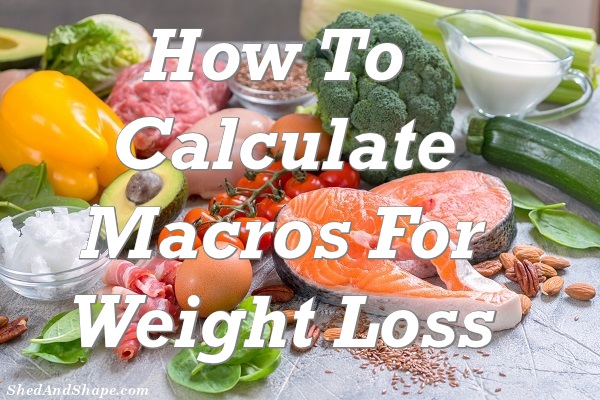Knowing how to calculate macros for weight loss is important if you’re following any low carb diet like keto. Unlike other diets, counting calories is not the main goal of the ketogenic diet. The goal is to get into the state of ketosis so your body will convert fats into energy instead of carbs. And to do that, you need to be able to keep track of your macros.
If you’re wondering how to calculate macros for weight loss in keto, then here’s everything you need to know.
What Are Macros?
First, let us understand what macros are. Macros is basically a shortened term for macronutrients. These refer to the carbs, proteins, and fats that make up the entire composition of the food you consume. As the Women’s Health Mag says,
“Macros is short for macronutrients, a term used to describe the three key food groups we all require for our bodies to function: carbohydrates, fats and proteins.”
When you follow a low carb diet like keto, you’ll go beyond counting calories. You will instead focus on keeping track of your macros. It’s also important that you pay attention to the net carbs in order to figure out the effective carbs from the foods you consume.
Net carbs refer to those carbs that your body can fully absorb. To calculate net carbs you subtract the fiber content from the total carbs. It’s the fiber that your body does not breakdown and absorb so you can’t count that portion as a carb.
A diet with well-balanced macros is important for overall health. Studies show that if you eat too little or too much of a single macro, you could increase your risk of developing heart diseases, diabetes, etc.
In keto, adhering to the proper keto macros is extremely important. If you get one of them wrong, your chances of reaching the state of ketosis are close to zero!
Remember that in order to get into ketosis, you must follow a high fat and low carb meal plan. That way, your body will start using ketones as your main energy source.
Understanding Keto Macros
Learning how to calculate macros for weight loss increases your awareness of the quality of the food you’re eating.
When you focus on the quality of your macros, you can increase your fat-burning potential while naturally regulating how many calories you consume.
And if you’re on a keto diet, keeping track of your macro is necessary to ensure that you’ll stay in ketosis.
But it’s important to note that the keto diet has a different macro component to a low carb diet. First, let’s talk about the keto macros.
Keto macros refer to the macronutrient ratio that one must follow when going keto. The standard macros that you should follow when you are on a ketogenic diet is this:
- 60 to 75% of calories would come from fat
- 15 to 30% of calories would come from protein
- 5 to 10% of calories would come from carbs
Take note that this macro ratio is different than the medical community would recommend. The Institute of Medicine suggests that people should get about 45 – 65% of their energy from carbs while about 30% would come from fats and the rest will come from protein.
As mentioned above, the macros for keto is different from a low carb diet. You’re not really required to strictly follow a certain macro ratio in a low carb diet. However, compared to keto, a low carb diet has a slightly higher carb intake, which is around 75 to 150 grams of carbs in a day.
The goal of a ketogenic diet is different from the usual health diets. With keto, your main goal is to change the way your body would utilize your nutrients to produce energy.
You must induce your body into the state of ketosis in order for your fats to be converted into energy, which results in weight loss. It is for this reason why most of the calories you need to consume in keto should come from fats.
Related reading: Best Fats To Eat On A Low Carb Diet
How to Calculate Macros for Weight Loss on Keto
The keto macros that followers of the keto diet will follow are roughly the same. But in order to achieve the best results, it’s important that you learn how to calculate macros for weight loss in keto based on your needs, goals, and overall physique. Here’s how to calculate macros for weight loss:
1. Start with your Net Carbs
In a keto diet, you should consider net carbs. This is the total amount of carbs less fiber. Fiber will not have any effect on your glucose level so it’s important that you deduct it from the total carbohydrates.
In keto, your daily net carbs should not go beyond 30 grams. With the low carb diet, you can have up to 150 grams of net carbs in a day.
2. Consider your Proteins
The amount of protein you consume in keto will mainly depend on whether you want to build muscles or simply lose weight. This will also be based on your body fat percentage.
Generally, you should have around 1.5 – 2.5 grams of protein for every kg of muscle mass in order to gain muscles. But if you’re not trying to build muscles, your protein allowance will be less.
3. Determine How Much Fat You Need
Finally, the most important aspect of how to calculate macros for weight loss is to determine how much fat you’re supposed to consume daily. This will mainly depend on whether you want to lose weight or maintain your current weight.
The best way to compute your daily fat allowance is to use one of the keto macro calculators that you’ll find online. When determining the amount of fats to take in, consider the fact that both protein and carbs have 4 calories for every gram while fats have 9 calories in each gram.
Therefore, if the calculator requires you to consume 200 g of fat each day, that would be equivalent to 1,800 calories from fat (200 grams x 9 calories).
In general, adult women should consume around 2,000 calories each day while men should have 2,500 calories. However, this figure will depend upon certain factors, such as your weight, age, physical activities, etc.
Conclusion
In order to be successful with your goal to lose weight while on keto, you should understand what a keto macro is and find out how to balance the macros perfectly in order to successfully achieve your weight loss goals.
The steps above should only serve as your guide on how to calculate macros for weight loss because determining the exact macro ratio can be a bit tricky. Nevertheless, once you get your macros in place, following the keto diet will be a breeze.










